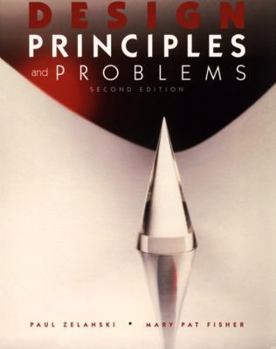Design Principles and Problems
Select Format
Select Condition 
Book Overview
This comprehensive text is now updated and includes equitable coverage of fine and commercial art. Media and methods span from the traditional to computer design, and a global emphasis reveals the... This description may be from another edition of this product.
Format:Paperback
Language:English
ISBN:0155016156
ISBN13:9780155016156
Release Date:October 1995
Publisher:Wadsworth Publishing
Length:320 Pages
Weight:0.05 lbs.
Dimensions:0.7" x 8.0" x 10.0"
Customer Reviews
5 ratings
Great Condition, Great Buy!
Published by Thriftbooks.com User , 15 years ago
This book was in perfect condition as the seller indicated in his description of the book, Design Principles and Problems. There where no ripped up pages, bended edges, no writing, or highlights in the book, and no pages where missing. This just goes to show that this seller lets his buyers know exactly the quality of the item they are buying, and from what I have seen from this seller their item quality is great!
Readable, Interesting, And Clear
Published by Thriftbooks.com User , 15 years ago
"The second edition of Design Principles and Problems is the result of a unique collaboration between an artist who has taught basis design to a great variety of college students for more than 37 years and an experienced professional writer of college textbooks. Together we have tried to create a book that prepares a solid foundation for studying all the fine and applied arts and is at the same time READABLE, INTERESTING, AND CLEAR....." [from the book of the preface]
Design Principles and Problems
Published by Thriftbooks.com User , 20 years ago
This book is beneficial in learning the vocabulary and basics of Graphic Design. I did find that it was necessary to go outside the book to fully understand Principles of Unity. The book is an excellent resource for the beginning Graphics Major.
Essential Manual for the Aspiring or Proffesional Artist
Published by Thriftbooks.com User , 21 years ago
I am an artist. It is more than a career choice, it is a lifestyle. If you want your art to be more effective, for personal or public reasons, studying design principles is paramount! I can't stress enough the importance of studying the elements and functions of design elements. This text, Design Principles & Problems, will put you on the right course for studying this subject. Currently we are using this text in my Design Foundations class. It is a rich maunual with many comparitive illustrations to referance during the course of your study. This isn't a book that you use, then discard, it is a keeper!
This book has many strengths, but some important weaknesses
Published by Thriftbooks.com User , 24 years ago
I have used Design Principles and problems for several years to teach Basic Two-Dimensional Design to both art majors and non-art majors. It is clearly written and well structured, with emphasis on the design principles and elements. I particularly like the chapters on the Unifying Principles, Shape and Form, and Color. There are many excellent projects and student examples, plus an explanation of what each project is trying to achieve.I do find, however, that I have to suppliment the text with a few chapters from other books and my own notes. Particularly, I am referring to the lack of any depth on the importance of the grid as one important formal way to create structure. Another area I find lacking is a chapter on structure itself with the many sources in nature as examples. The importance of the use of the Golden Mean is also not covered, even while it is still used by many contemporary artists and was used by many artists in 19th century as an understructure in creating a painting. For instance, the analysis on Seurat's "Circus Sideshow" talks about the repetition of the brush strokes, textures, colors, and gaslights as a means to unify the picture but neglects the fact that the entire picture is divided up into squares and rectangles with a loose grid formed by the continuation of the edges of figures and rectangles. It is at once an asymmetrical picture with strong use of approximate symmetry on both sides of the central musician. The Golden Mean is at work in the creation of the proportions in this picture yet is never mentioned.Because of these shortcomings I continue to look for alternatives and go back to using classics like Lauer's Design Basics from time to time, supplimented with examples from Wucius Wong's books and those of my own students.All in all, though, Design Principles and Problems has many strengths and it most definitely belongs in your library if you teach Basic Design.





